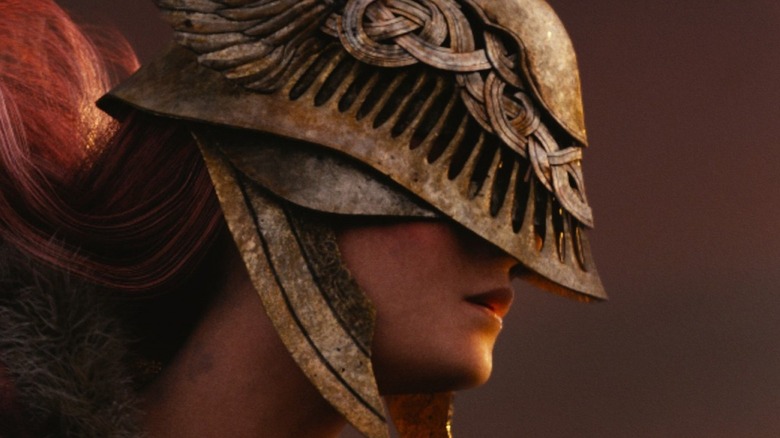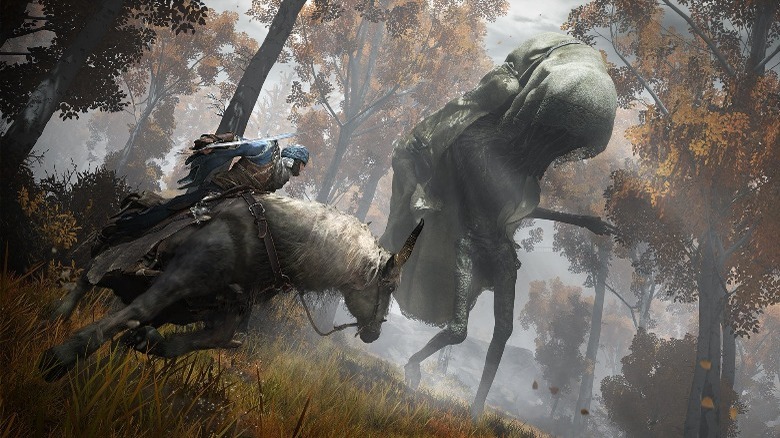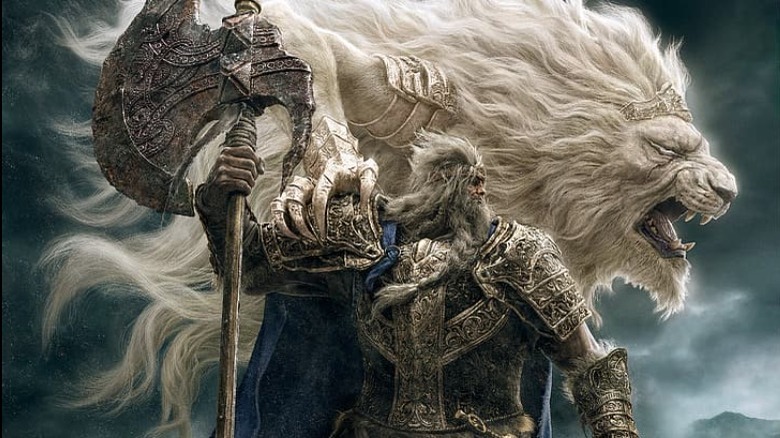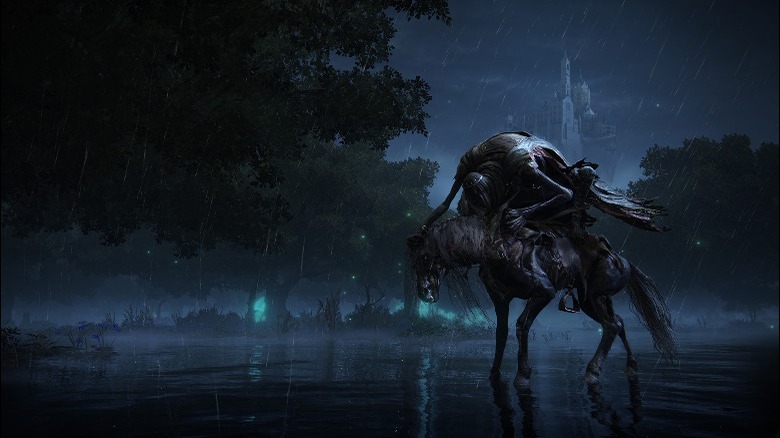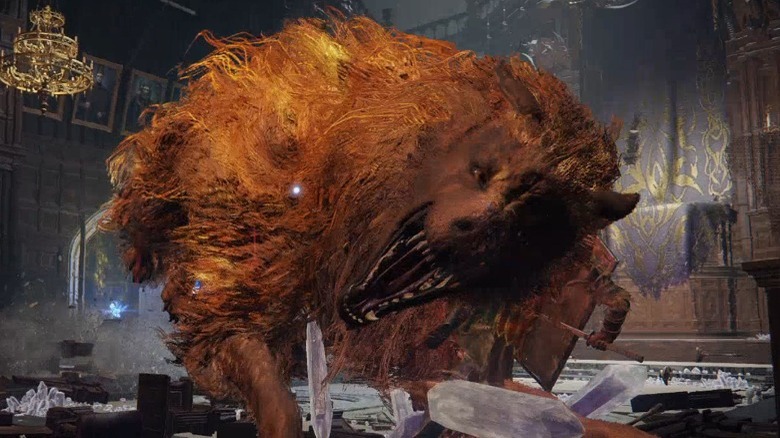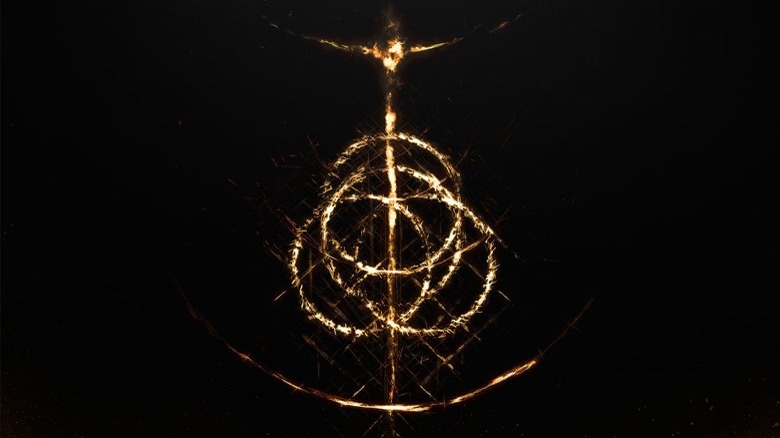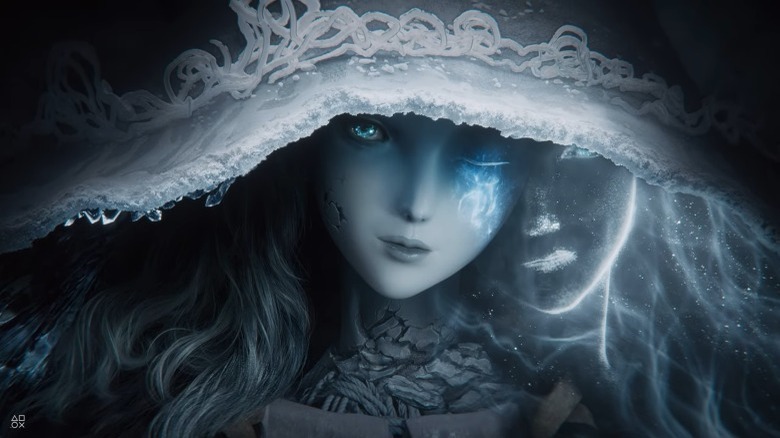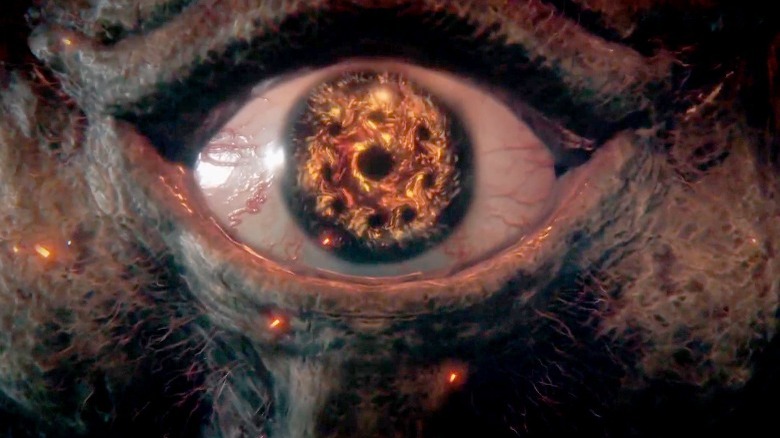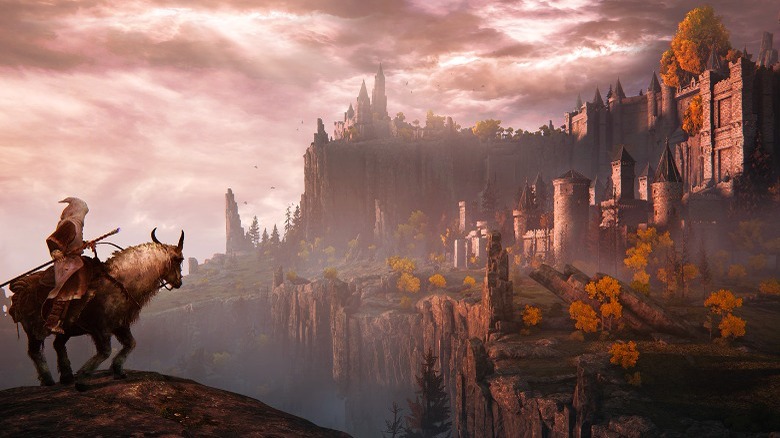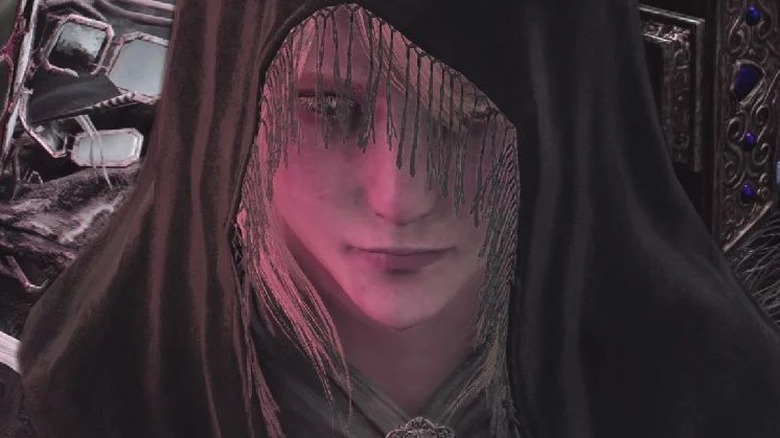The Ending Of Elden Ring Explained
It will likely be a long, long time before players uncover every secret in "Elden Ring," the latest offering from Hidetaka Miyazaki and FromSoftware. The massive title has critics raving over its expansive world and approachability for Soulsborne beginners, but fans have been enjoying its challenge and, of course, all the horrible ways the Tarnished can die.
Gamers are also enjoying unpacking the lore of "Elden Ring," which, like most FromSoftware games, is incredibly opaque. The game doesn't handhold players through the plot. Instead, it provides vague ideas about where to go, plenty of clues, and a story gamers have to uncover on their own. Some gamers, like journalist Jason Schreier, even suggest keeping a notebook to document various plot points and missions, because "Elden Ring" doesn't provide players with things like quest markers or records of what they've done.
Eventually, all of that hard word culminates in an epic – or disappointing – ending. If something about the climax of "Elden Ring" isn't quite adding up, you've come to the right place. Here's the ending of "Elden Ring" explained.
A world shattered
Before jumping straight into the ending of the game, it's important to know why players are journeying through The Lands Between in search of the titular broken Elden ring. Players step into the shoes of a Tarnished, a warrior who lost the "grace of the Erdtree," and were cast out from the world. Lost grace – points of gathering light symbolic of the Erdtree's power – call out to the Tarnished and urge them to return to the Lands Between, perhaps in an attempt to restore order to the world and bring the Erdtree back to its full power. The Erdtree, which looms over players throughout their journey, is a massive, glowing, golden tree that provides life to the world, in some sense.
The Tarnished all have different motivations for their travels, but at least some of them – like the player – might be interested in finding the shards of the broken ring and either reuniting the world or becoming the Elden Lord themselves. NPC interactions seem to indicate that most Tarnished aren't having a great time out in the world, and as in many FromSoftware games, things seem pretty bleak.
That being said, players do have a chance to potentially restore order to the Lands Between by reforging the ring, hinting at a tentatively optimistic ending to "Elden Ring." Of course, all of this is left up to some interpretation.
Who are the shardbearers?
Queen Marika the Eternal, the original keeper of the Elden Ring, had several children who would later become keepers of varying pieces of the ring. Each demigod child wanted to hold onto their small part of the Elden ring as a means to retain control of power. Even though their mother wasn't powerful like she used to be – and even though she was imprisoned in the Erdtree – the shardbearers each had a slice of power in their Great Runes, which the Tarnished player can obtain throughout the game.
However, the shardbearers aren't just normal people, and Marika wasn't quite a normal person, either. Marika is a goddess, split into a female half and a male half (Radagon). Her children don't particularly seem to want to free her throughout the plot of "Elden Ring," but they do have a great interest in stopping the Tarnished from upsetting the status quo. In typical "Souls" fashion, players don't get a clear map of where the shardbearers are or how to defeat them. Instead, that's something they have to discover for themselves.
What happens to the lords?
Each shardbearer, each Lord in "Elden Ring," must be felled by the Tarnished player. They're a series of bosses that must be defeated in order to progress through the story of "Elden Ring," unlike lesser invaders and field bosses found in the game. Each time a Lord is vanquished, a bit more lore unfurls, explaining the world of the game, albeit in an opaque way.
For example, fighting and defeating Rennala of the Full Moon and speaking to some NPCs unlocks new dialogue that explains what Rennala's been up to in the Academy. It turns out that Rennala is waiting for her husband (who is in the egg she holds) to be reborn and join her in life once again – or at least that's what one Redditor claimed in response to a plea for someone to explain what was going on with the eldritch academy. For those struggling to understand the lore of "Elden Ring," often the only answer is time – and fighting more bosses – which will eventually open new dialogue branches with various characters around the Lands Between.
Radagon of the Golden Order
The final boss of "Elden Ring" is Radagon of the Golden Order, the male half of the goddess Marika and former husband of Rennala. The family tree of the gods in "Elden Ring" is extremely confusing, but ultimately players should know that Radagon is – like Marika – divine. Radagon both is and isn't her (the pair are likely based on the Rebis from alchemical theory), but his blows hit with all the force of a god. The battle with Radagon is grueling and multiphased. It begins with the Tarnished fighting Radagon in a human-ish form, shirtless and glowing with a golden light, his red locks blowing in the frenzy of battle. After defeating him, players might be horrified to see Radagon rise again, this time in the form of an Elden Beast.
The Elden Beast puts up a good fight, but its very existence might confuse some gamers. One player theorized that the Elden Beast is a physical manifestation of the Greater Will, the guiding presence of the world. It's possible that after defeating Radagon/Marika, the player has nothing left to hold them back from the Elden ring than the force of the universe itself, which must manifest in a physical form to attempt to change fate.
Regardless, defeating the various Lords throughout "Elden Ring," culminating in vanquishing Radagon himself, allows players with the opportunity to wield the power of the Elden ring themselves.
Repairing the ring and restoring order
Players have a choice after defeating the Elden Beast. They can repair the Elden ring and assume power for themselves, or they can attempt to mend the broken world. The Elden Lord ending assumes that players will repair Marika and end the Age of Fracture. After defeating the Elden Beast, players that want to achieve this ending can mend Marika's body and restore the ring to its whole form, triggering a final scene to wrap up the narrative.
A voiceover explains that the "fallen leaves tell a story of how a Tarnished became Elden Lord." The voiceover says that future generations reflect on the time and consider it to be an "Age of Fracture," but that the divisive time was brought to a close by the brave Tarnished that restored the ring, and therefore order. This is the most straightforward ending, which can be achieved without any specific sidequests or items. However, there are other, more elaborate and narratively interesting final scenes to experience.
Ranni's Ending
Ranni is a witch players can meet early in "Elden Ring," although she goes by the name Renna at first. She claims to be looking for hidden treasure and enlists the player to help her on her quest to seek the "dark path." Eventually, Ranni urges players to free the stars and bring her a special dagger. But why is Ranni doing this and what does she want by ushering in the Age of the Moon?
Considering that Glintstone magic, the primary magic of the game, seems to involve the positions of the stars, it's possible that Ranni is looking to become more powerful than Marika, or even the Greater Will. Whatever the case, her ending definitely doesn't bode well for the inhabitants of the Lands Between, as she ushers in the "Age of the Moon," a time of fear and cold. That doesn't sound like a particularly good time.
Some fans believe that Ranni's ending could be a precursor to "Bloodborne," another FromSoftware game that focuses on the moon, monstrosity, and one long night of the hunt. Either way, Ranni's ending, known as "The Age of the Star," is one of the most complex endings to achieve in "Elden Ring," simply because of its many branching sidequests and steps. Ranni's ending insinuates that the Tarnished will become Ranni's consort, ruling the darkness alonside her.
The Lord of Frenzied Flame Ending
If players don't want to become the Elden Lord or let Ranni rule the Lands Between, there's always another path: chaos. Where the Tarnished can right the world as a just ruler, and Ranni can attempt to usher in a different sort of age ruled by the Moon, the Tarnished can also choose to literally burn everything down in the Lord of Frenzied Flame ending.
Actually getting the most chaotic ending requires players to journey to meet the Three Fingers while completely naked. The Three Fingers will brand the player, burning scars into their skin, then release them to continue on their journey. If players proceed to fight Radagon, the ending they receive will be much different after they're marked. Instead of fusing the ring back together or helping Ranni, players will burn down the Erdtree and everything else in their path, their head transformed into a giant ball of fire. From there, players can either choose to save Melina or burn her, as well.
While the other endings of "Elden Ring" focus on putting someone in power as a new Elden Lord, the Lord of Frenzied Flame supposes that the Lands Between don't deserve to be saved, and that things might be better if the Erdtree burned down entirely. This ending suggests that the Elden Lord/Tarnished cycle is neverending. There will always be someone corrupted by power, and there will always be someone seeking to end that power.
How does Elden Ring resolve its themes?
As with many FromSoftware games, the true joy of "Elden Ring" is the journey to completing the game and earning the honor of beginning a New Game+, upping the challenge even more. However, there are still some key themes the game communicates to players as they venture through the Lands Between. No matter what ending players complete, the game shows that the cycle of power is endlessly corrupted, and no matter who becomes Elden Lord, things don't seem bound to change for the residents of the Lands Between. In fact, there don't seem to be many residents at all that aren't already monstrous and dangerous. Even if the Tarnished saves the world, there's not much of a world to save, and that won't be improved by a change in leadership.
If Ranni comes to power, she discusses a new age of fear, where she'll exercise her power over the world. If the Tarnished comes to power, they sit on a throne, superior to everyone and lording their rank above the world. If the Erdtree is burned down in the end, well, there's nothing left to rule over, is there? No matter what sort of ending players receive, it suggests that for as long as someone is in charge – no matter who that person is – the Lands Between will suffer.
More than one way to end things
It's worth noting that there's no one linear way to complete "Elden Ring." While some bosses (like Margit the Fell Omen) are mandatory, others are completely optional and avoidable. Better yet, there are a multitude of other bosses – the final challenge in small dungeons, or random dragons out in the world – that players can choose to defeat or spare. This allows players to build their own narrative and infuse meaning into the game's ending for themselves.
There could be more than three endings to "Elden Ring," as well. It's a massive title with tons of secrets left to uncover, and players might not have found every possible ending just yet. As of now, there are three possible endings (with some minor variations) available, but it's entirely likely that gamers will find more in the future.
As far as optional bosses go, there are some players will definitely want to check out. For example, the red haired woman who became the love of the internet back when the trailer for "Elden Ring" first appeared is actually a brutal foe named Malenia, Blade of Miquella. Fighting her reveals more of the game's story, but doesn't necessarily fit into the Tarnished's quest for the Elden ring. Pursuing optional bosses and dungeons always holds the potential to change the story – and therefore the ending – by uncovering new parts of the world's lore and giving players a better understanding of the dense backstory of "Elden Ring."

